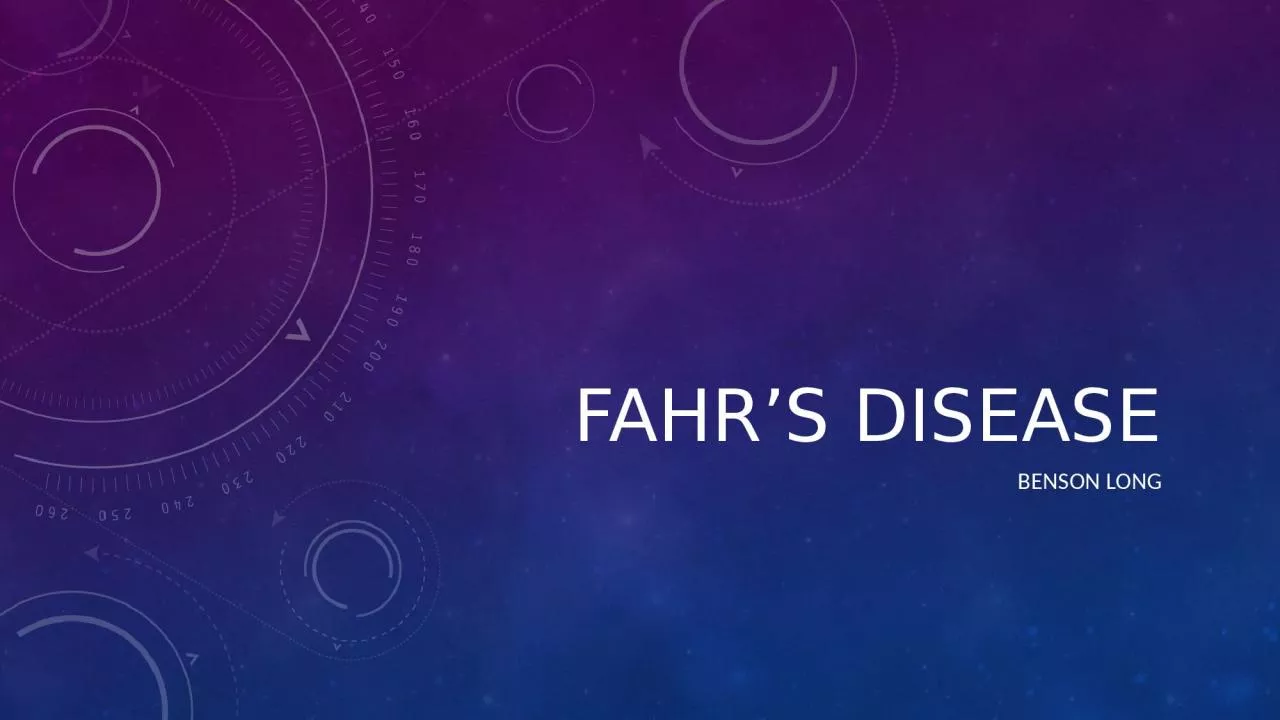

What is Fahrs Disease Neurological disorder Abnormal calcium deposits in the brain basal ganglia Idiopathic Basal Ganglia Calcification IBGC Diagnostic Techniques Computed Tomography ID: 916334
Download Presentation The PPT/PDF document "Fahr’s Disease Benson Long" is the property of its rightful owner. Permission is granted to download and print the materials on this web site for personal, non-commercial use only, and to display it on your personal computer provided you do not modify the materials and that you retain all copyright notices contained in the materials. By downloading content from our website, you accept the terms of this agreement.
Slide1
Fahr’s Disease
Benson Long
Slide2What is Fahr’s Disease?
Neurological disorder
Abnormal calcium deposits in the brain (basal ganglia)
Idiopathic Basal Ganglia Calcification (IBGC)
Slide3Diagnostic Techniques
Computed Tomography
Magnetic Resonance Imaging
Plain skull radiograph
Slide4Diagnostic Criteria
Bilateral calcification of basal ganglia
Progressive neurologic dysfunction
30 to 60 years of age
Free from mitochondrial, metabolic or other systemic diseases
Absence of infectious, toxic or traumatic cause
Autosomal dominant inheritance
Slide5Case Study #1
34 year old female
Numbness on tongue and arms, tremor, sleep loss, loss of consciousness
Decreased calcium and PTH levels and increased phosphorus levels
Bilateral symmetric calcifications in caudate and
lentiform
nuclei and thalamus
Slide6Case Study #2
25 year old female
Loss of memory, irritability, poor night time sleep and social isolation
Illiterate
depression
No
muscular problems
Negative lab test results
Slide7Case Study #3
63 year old male
Difficulty in speech, slowness in movements,
bradykinesia
No mood changes or seizures
No contributory family history
Normal lab tests results of calcium, phosphorous & PTH
Slide8Genetics
14q locus (IBGC1)
Chromosome 8 (SLC20A2)
Slide9IBGC1
Slide10SLC20A2
Sodium-dependent phosphate transporter
Not
regulated in the brain
Mutation
in SLC20A2
decrease in SLC20A2 mRNA expression abnormal local Pi homeostasis calcification of basal ganglia
SLC20A1 (co-expressed)
resistance to SLC20A2 mutations calcifications in brain but not elsewhere
Slide11Symptoms
Abnormal movements/EPS (55%)
Parkinsonism (57%)
Chorea (19%)
Tremor (8%)
Dystonia (8%)
Athetosis
(5%)
Orofacial
dyskinesia (3%)
Asymptomatic
Slide12The Brain
Slide13Basal Ganglia
Slide14Basal Ganglia
Slide15Slide16Direct Pathway
Glutamate (excitatory)
GABA (inhibitory)
Slide17Indirect Pathway
Slide18Dopamine & Acetylcholine
Slide19Dopamine & acetylcholine
ACh
TURNS DOWN MOTOR ACTIVITY
ACh
inhibits striatal cells in the direct loop
ACh
excites striatal cells in the indirect
loop
DA TURNS UP MOTOR ACTIVITY
DA excites striatal cells in the direct loop via D1 receptors
DA inhibits striatal cells in the indirect loop via D2 receptors
Slide20Hyperkinesia
Huntington’s chorea
Damaged
subthalamic
nucleus
Loss of Striatal-GP(
ext
) &
ACh
cells
Slide21Hypokinesia
Parkinson’s
disease
Loss of dopamine cells in
substantia
nigra
Ach interneurons still functional
Slide22Calcium Functions
Skeleton structure
Muscle contraction (sliding filament)
Secondary messenger
Exocytosis of neurotransmitters
Blood clotting
Slide23Calcification
Excess calcium
Problem
with calcium transporters
Calcium carbonate & calcium phosphate
Sign of tissue damage, cellular aging and impending cell death
Slide24Magnesium
Affects ATP (mitochondria)
Calcium pump inhibition
Magnesium makes
calcium
more
H
2
O
soluble (more soluble in urine)
Relaxes muscles
Activates
thyrocalcitonin
Slide25Magnesium
Recommended 2:1
Ca
2+
to
Mg
2+
Absorption of Mg greater than Ca
2+
but similar
Caveman
dietMg2
+
is excreted with excess
Ca
2+
so excess
Ca
2+
excretion = lower
Mg
2
+
levels
Mg
2
+
regulate
influx
of
Ca
2+
in postsynaptic
Ca
2+
channels
from presynaptic neurons in brain
Slide26Sodium thiosulfate
Reacts with Ca
2+
to form
calcium
thiosulfate = more soluble in urine
decalcification
Calcified deposits pH decreased
Ca
buffer system form blood, bones & tissues Oxygen
lvls
fall in acidic conditions
Slide27Treatments
Early diagnosis
Measure electrolyte levels (
Ca
2+
, Pi & Mg
2+
)
and PTH
Examine CSF for infections and
viruses
Test SLC20A2 gene
Slide28The Future
Research on the causes of bilateral calcification
Development of effective medical treatments
Slide29Conclusion
No specific etiologic cause
Symptoms may be confused with other conditions
Lack of effective treatment
Future research is being done
Slide30Citations
Amin, O.
(2012).
Fahr's
Disease and Frontal Lobe-Like Cognitive Dysfunction.
Journal of Mood Disorders
,
2
(3): 119-122.
doi
: 10.5455/jmood.20120608073057
Reeves, A. G. & Swenson, R. S.
Chapter 26 – Disorders of basal ganglia function
. Retrieved from https://www.dartmouth.edu/~dons/part_3/chapter_26.
html
Basal Ganglia
(PDF document).
Retrieved from
http://www.neuroanatomy.wisc.edu/coursebook/motor2.
pdf
Sun, M. Yang, S. Juan, C. & Lin, S. (2010). Symmetrical Brain Calcifications.
The American Journal of Medicine
,
123
(2): 131-133.
doi
: 10.1016/j.amjmed.2009.12.002
Slide31Citations
Geschwind
, D. H.,
Loginov
, M. & Stern, J. M. (1999). Identification of a Locus on Chromosome 14q for Idiopathic Basal Ganglia Calcification (
Fahr
Disease).
American Journal of Human Genetics
,
65
:
764-772.
Paraskevas
, G. P., Vlachos, G. S., Vassilopoulou
, S.,
Anagnostou
, E.,
Spengos
, K. &
Zis
, V. (2012). Hypoglycemia-induced
hemichorea
in a patient with
Fahr’s
syndrome.
Neurological Sciences
, 33: 1397-1399.
doi
: 10.1007/s10072-012-1096-8
Zhang, Y.,
Guo
, X. & Wu, A. (2013). Association between a Novel Mutation in SLC20A2 and Familial Idiopathic Basal Ganglia Calcification.
Plos
One
,
8
(2): e57060.
d
oi
: 10.1371/journal.pone.0057060
Saleem
, S.,
Aslam
, H. M., Anwar, M., Anwar, S.,
Saleem
, M.,
Saleem
, A. &
Rehmani
, M. A. K. (2013).
Fahr’s
syndrome: literature review of current evidence.
Orphanet
Journal of Rare Diseases
,
8
: 156.
doi
: 10.1186/1750-1172-8-156
Slide32Citations
Asokan
, A
. G.,
D'souza
, S.,
Jeganathan
, J., &
Pai
,
S. (2013).
Fahr's
Syndrome - An Interesting Case Presentation. Journal of Clinical and Diagnostic Research, 7(3):
532-533
. doi:10.7860/JCDR/2013/4946.2814
Arslan
, E
. D.,
Yilmaz, F.,
Koca
, S.,
Uyanik
, B.,
Sonmez
, M., &
Kavalci
,
C. (2013).
Fahr's
Disease and Its Relationship with
Hypoparathyroidism
: Case Report.
Journal of Academic Emergency Medicine
,
4
:
95-97.
doi
: 10.5505/jaemcr.2013.59354
Sircus
, M. (2009, December 8). Calcification and Its Treatment with Magnesium and Sodium Thiosulfate.
DrSircus.com
.
Retrieved
from
http://
drsircus.com/medicine/magnesium/calcification-and-its-treatment-with-magnesium-and-sodium-thiosulfate
NINDS
Fahr's
Syndrome Information Page. (2007, February 13).
National Institute of Neurological Disorders and Stroke
. Retrieved
from
http://
www.ninds.nih.gov/disorders/fahrs/fahrs.htm
Fahr’s
syndrome.
Wikipedia: The Free Encyclopedia
.
Retrieved from
http://
en.wikipedia.org/wiki/Fahr's_syndrome
Goel
, A. & Ho, M. et al.
Fahr
disease.
Radiopaedia.org
. Retrieved from
http://radiopaedia.org/articles/fahr-disease